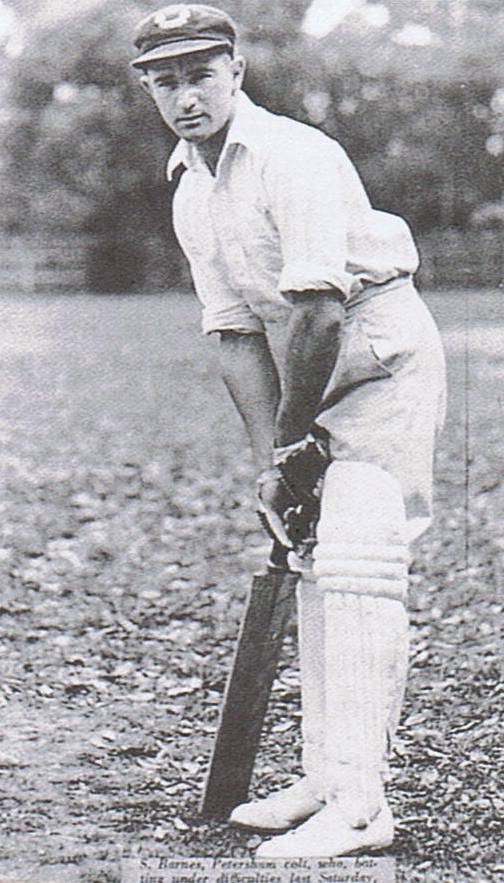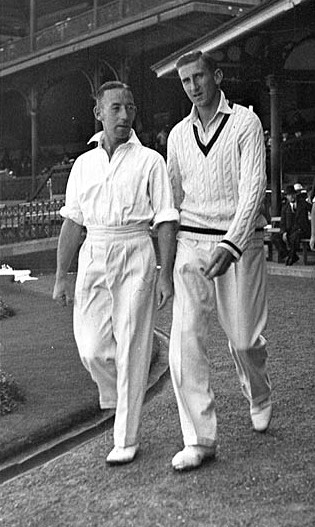|
First Test, 1948 Ashes Series
The First Test of the 1948 Ashes series was one of five Tests in the The Ashes cricket series between Australia and England. The match was played at Trent Bridge in Nottingham from 10 to 15 June with a rest day on 13 June 1948. Australia won the match by eight wickets to take a 1–0 series lead. The Australians started the match as firm favourites, having won the previous series against England 3–0; in the lead-up to the 1948 series, they had won 10 of their 12 tour matches in England, mostly by large margins. This included a crushing innings defeat in a match over the Marylebone Cricket Club—a team consisting almost entirely of Test-capped and current England players. England captain Norman Yardley won the toss and elected to bat on a cloudy day. After the first morning was interrupted by inclement weather, the Australian fast bowlers quickly made inroads into the English batting. Despite the loss of leading Australian paceman Ray Lindwall with a groin injury, the hos ... [...More Info...] [...Related Items...] OR: [Wikipedia] [Google] [Baidu] |
Stumps
In cricket, the stumps are the three vertical posts that support the bails and form the wicket. '' Stumping'' or ''being stumped'' is a method of dismissing a batsman. The umpire ''calling stumps'' means the play is over for the day. Part of the wicket The stumps are three vertical posts which support two bails. The stumps and bails are usually made of wood, most commonly ash, and together form a wicket at each end of the pitch. The overall width of each wicket is 9 inches (22.9 cm). Each stump is 28 inches (71.1 cm) tall with maximum and minimum diameters of 1 inches (3.81 cm) and 1 inches (3.49 cm). They have a spike at one end for inserting into the ground, and the other end has a U-shaped 'through groove' to provide a resting place for the bails. In junior cricket the items have lesser dimensions. Each stump is referred to by a specific name: * Off stump is the stump on the off side of the wicket (the same side as the batsman's bat). * Mid ... [...More Info...] [...Related Items...] OR: [Wikipedia] [Google] [Baidu] |
Lancashire County Cricket Club
Lancashire County Cricket Club represents the historic county of Lancashire in English cricket. The club has held first-class status since it was founded in 1864. Lancashire's home is Old Trafford Cricket Ground, although the team also play matches at other grounds around the county. Lancashire was a founder member of the County Championship in 1890 and have won the competition nine times, most recently in 2011. The club's limited overs team is called Lancashire Lightning. Lancashire were widely recognised as the Champion County four times between 1879 and 1889. They won their first two County Championship titles in the 1897 and 1904 seasons. Between 1926 and 1934, they won the championship five times. Throughout most of the inter-war period, Lancashire and their neighbours Yorkshire had the best two teams in England and the Roses Matches between them were usually the highlight of the domestic season. In 1950, Lancashire shared the title with Surrey. The County Championshi ... [...More Info...] [...Related Items...] OR: [Wikipedia] [Google] [Baidu] |
Sid Barnes
Sidney George Barnes (5 June 1916 – 16 December 1973) was an Australian cricketer and cricket writer, who played 13 Test cricket, Test matches between 1938 and 1948. Able to Batting order (cricket)#Opening batsmen, open the innings or Batting order (cricket)#Top order, bat down the order, Barnes was regarded as one of Australia's finest batsmen in the period immediately following the World War II, Second World War. He helped create an enduring record when scoring 234 in the second Test against England at Sydney in December 1946; exactly the same score as his captain, Donald Bradman, Don Bradman, in the process setting a world-record 405-run wicket#Partnership, fifth wicket partnership (cricket), partnership. Barnes averaged 63.05 over 19 innings in a career that, like those of most of his contemporaries, was interrupted by the Second World War. He made his First-class cricket, first-class debut at the end of the 1936–37 season when selected for New South Wales cric ... [...More Info...] [...Related Items...] OR: [Wikipedia] [Google] [Baidu] |
Hit Wicket
Hit wicket is a method of dismissal in the sport of cricket. This method of dismissal is governed by Law 35 of the Laws of Cricket. The striker is out "hit wicket" if, after the bowler has entered his delivery stride and while the ball is in play, his wicket is put down by his bat or his person. The striker may do this whilst preparing to receive or receiving a delivery or in setting off for his first run after playing the delivery. In simple language, if the striking batsman knocks the bails off the stumps or uproots the stumps, while attempting to hit the ball or take off for a run, he is out hit wicket. This method is the sixth most common method of dismissal after caught, bowled, leg before wicket, run out and stumped. It is significantly rarer than any of these, which constitute the five conventional methods, but still much more common than the other four (timed out, obstructing the field, retired out and hit the ball twice), which are extremely rare. Although a bowler is ... [...More Info...] [...Related Items...] OR: [Wikipedia] [Google] [Baidu] |
Batting Order (cricket)
In cricket, the batting order is the sequence in which batters play through their team's innings, there always being two batters taking part at any one time. All eleven players in a team are required to bat if the innings is completed (i.e., if the innings does not close early due to a declaration or other factor). The batting order is colloquially subdivided into: * Top order (batters one to three) * Middle order (batters four to eight), which can be further divided into: ** Upper middle order (batters four and five); and ** Lower middle order (batters six to eight) * Tail enders (batters nine to eleven) The order in which the eleven players will bat is usually established before the start of a cricket match, but may be altered during play. The decision is based on factors such as each player's specialities; the position each batter is most comfortable with; each player's skills and attributes as a batter; possible combinations with other batters; and the match situation where ... [...More Info...] [...Related Items...] OR: [Wikipedia] [Google] [Baidu] |
Denis Compton
Denis Charles Scott Compton (23 May 1918 – 23 April 1997) was an English multi-sportsman. As a cricketer he played in 78 Test matches and spent his whole cricket career with Middlesex. As a footballer, he played as a winger and spent most of his career at Arsenal. A right-handed batsman and left-arm unorthodox spin bowler, Compton is regularly credited as one of England's most remarkable batsmen. Indeed, Sir Don Bradman said he was one of the greatest cricket players he'd ever seen. He is one of only twenty-five players to have scored over one hundred centuries in first-class cricket. In 2009, Compton was posthumously inducted into the ICC Cricket Hall of Fame. The Denis Compton Oval and a stand at Lord's Cricket Ground are both named in his honour. Cricket career Early years Compton was born and brought up in what was then the urban district of Hendon, which later became part of Greater London; his father had moved there in hopes of finding more work. He was the second s ... [...More Info...] [...Related Items...] OR: [Wikipedia] [Google] [Baidu] |
Len Hutton
Sir Leonard Hutton (23 June 1916 – 6 September 1990) was an English cricketer. He played as an opening batsman for Yorkshire County Cricket Club from 1934 to 1955 and for England in 79 Test matches between 1937 and 1955. ''Wisden Cricketers' Almanack'' described him as "one of the greatest batsmen in the history of cricket". He set a record in 1938 for the highest individual innings in a Test match in only his sixth Test appearance, scoring 364 runs against Australia, a milestone that stood for nearly 20 years (and remains an England Test record). Following the Second World War, he was the mainstay of England's batting. In 1952, he became the first professional cricketer of the 20th century to captain England in Tests; under his captaincy England won the Ashes the following year for the first time in 19 years. Marked out as a potential star from his teenage years, Hutton made his debut for Yorkshire in 1934 and quickly established himself at county level. By 1937, he was ... [...More Info...] [...Related Items...] OR: [Wikipedia] [Google] [Baidu] |
Bouncer (cricket)
In the sport of cricket, a bouncer (or bumper) is a type of short-pitched delivery, usually bowled by a fast bowler, which bounces once and then reaches the batter at head-height. Usage Bouncers are used to drive the batter back on to his back foot if he has been freely playing front foot scoring shots, such as drives. To this end, bouncers are usually directed more or less at the line of the batter's body. Aiming at the batter is legal provided the ball bounces on the pitch; or upon reaching the batter, the ball is below the batter's waist. Aiming at the batter's head without bouncing on the pitch, known as a beamer, is illegal. A batter may play a bouncer in either a defensive or an attacking way. If the batter plays it defensively he aims primarily to avoid getting out, and secondarily to avoid being hit by the ball. For a head-high bouncer, these goals are achieved most easily by ducking under the ball. If the ball is at chest height, the batter best defence is to move ... [...More Info...] [...Related Items...] OR: [Wikipedia] [Google] [Baidu] |
Lindsay Hassett
Arthur Lindsay Hassett (28 August 1913 – 16 June 1993) was an Australian cricketer who played for Victoria and the Australian national team. The diminutive Hassett was an elegant middle-order batsman, described by ''Wisden'' as, "... a master of nearly every stroke ... his superb timing, nimble footwork and strong wrists enabled him to make batting look a simple matter".Haigh, p. 3. His sporting career at school singled him out as a precocious talent, but he took a number of seasons to secure a regular place in first-class cricket and initially struggled to make large scores. Selected for the 1938 tour of England with only one first-class century to his name, Hassett established himself with three consecutive first-class tons at the start of the campaign. Although he struggled in the Tests, he played a crucial role in Australia's win in the Fourth Test, with a composed display in the run-chase which sealed the retention of the Ashes. Upon returning to Australia, he distingu ... [...More Info...] [...Related Items...] OR: [Wikipedia] [Google] [Baidu] |
List Of Cricket Terms
This is a general glossary of the terminology used in the sport of cricket. Where words in a sentence are also defined elsewhere in this article, they appear in italics. Certain aspects of cricket terminology are explained in more detail in cricket statistics and the naming of fielding positions is explained at fielding (cricket). Cricket is known for its rich terminology.''Glossary of cricket terms'' from the retrieved 13 May 2008Cricket Academy – Glossary from ... [...More Info...] [...Related Items...] OR: [Wikipedia] [Google] [Baidu] |








